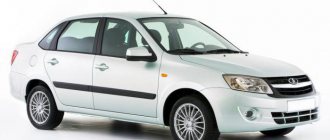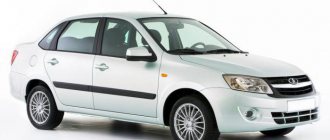Work on a new family of golf-class cars began at AvtoVAZ in the mid-2000s. Together with the Magna company in Tolyatti, they developed a new front-wheel drive platform, and work was underway on the creation of new engines and gearboxes.
At the 2004 Moscow Motor Show, the first result of the work was shown - the VAZ-2116 Silhouette conceptual sedan. It was also planned to create a hatchback, station wagon, and crossover; the start of mass production was scheduled for 2012.
In 2006, a modernized version of the model appeared under the name Lada Concept C, and by 2008, several running prototypes were produced for testing with the final design version (black car in the first illustration).
After becoming a co-owner, AvtoVAZ was officially closed.
This page contains information about the VAZ-2116 Silhouette concept car, which is not a production model.
This page is searched for the following queries: price of VAZ-2116 Silhouette, car characteristics, detailed information about the VAZ-2116 Silhouette model.
Project LADA C
- a joint project between AVTOVAZ and the Canadian company, which involves the creation of a series of C class cars. Existed in Russia from 2004 to 2009.
“Project Lada C” provided for the joint creation of ten series of car models under the Lada brand at the existing facilities of AVTOVAZ. The launch of new models into mass production was scheduled for 2009. It was planned to create a joint venture, which was to be headed by one of the vice-presidents of the Russian Technologies Corporation, Maxim Nagaitsev. [1]
On December 22, 2006, a framework agreement was signed between the state corporation Russian Technologies and the Canadian company Magna International on cooperation in the production of auto components for the new project C.
In 2009, cooperation with Magna International
was frozen in favor of the Franco-Japanese alliance "Renault Nissan", the French company Renault acquired a 25% stake in AvtoVAZ.
The Alliance provided its B platforms, which in 2012 were installed on the first line of the AVTOVAZ main conveyor. CEO Sergei Chemezov said that the developments with Magna International
remain valid and will be used to create new cars. [2]
Since 2009, due to the difficult economic situation of AvtoVAZ OJSC, Project C has been suspended. The LADA B platform and a number of developments formed the basis of the new LADA Vesta model.
LADA C series of cars [edit | edit code ]
Lada C Concept [edit | edit code ]
| Lada C Concept | |
| Total information | |
| Manufacturer | AvtoVAZ |
| Years of production | 2007 |
| Assembly | AvtoVAZ (Tolyatti, Russia) |
| Class | Compact |
| Design | |
| Body type | 3-door hatchback (5-seater) |
| Platform | Project Lada C |
| Layout | front engine, front wheel drive |
| Wheel formula | 4 × 2 |
| Engine | |
| 2.0 l | |
| Weight and dimensions characteristics | |
| Length | 4208 mm |
| Width | 1835 mm |
| Height | 1548 mm |
| On the market | |
| Segment | C-segment |
| Media files on Wikimedia Commons | |
Meager interior and its problems
Compared to the previous “ninth family”, the interior of the “twelve” is definitely a step forward. There are door panels upholstered in velor, softer armchairs, and a rear sofa with headrests that folds in a 3:2 ratio to a flat floor.
There is not enough space in the cabin; three people cannot sit in the back seat. Tall rear seat passengers will have their knees resting on the backs of the front seats and their heads on the ceiling. The trunk is designed for 400 liters of cargo.
In terms of options, you won’t find anything supernatural: only electric windows and heated front seats. There are VAZs with alloy wheels; in later versions, air conditioning and power steering are available. There is no safety in the “two-wheeler”: there are no airbags or ABS.
The windshield and front windows constantly fog up in high humidity. You shouldn’t count on airflow: the ventilation in the cabin is not thought out properly. Moisture also accumulates in the trunk pockets and the niche under the spare wheel, and “saffron milk caps” form there over time.
Also read: Berry again? Review of Lada Kalina II
History of VAZ 2116
- in 2004, the first sketches of the project appeared.
- In 2004, a model of the VAZ-2116 Silhouette was presented at the Moscow Motor Show.
- an exhibition copy was assembled in 2005.
- in 2006, production of experimental samples began (35 bodies and 28 prototypes)
- in 2006, at the Moscow Auto Show, a prototype was shown, in which the main solutions of the new platform were only tested.
- in 2007, at the Interauto-2007 exhibition, a more developed prototype of the VAZ 2116 was shown.
- The plans were to launch serial production in 2009-2015. Later, start building the VAZ 2117 station wagon and VAZ 2118 hatchback on the same base.
- in 2014, AvtoVAZ completely abandoned the prospects of a large sedan (the release date was never announced).
The relationship between the Lada Vesta sedan and the VAZ 2116 has not been officially confirmed, but according to indirect evidence, the VAZ team used the experience gained in creating a new car. For example, the VAZ 2116 also had a suspension on L-shaped arms.
Modifications
| Name | Year of issue | |
| LADA 112 (2112) 1.5 | 01.1995 — 10.2000 | Characteristics |
| LADA 112 (2112) 1.5 | 01.1995 — 09.2004 | Characteristics |
| LADA 112 (2112) 1.5 16V | 01.1995 — 09.2000 | Characteristics |
| LADA 112 (2112) 1.5 16V | 10.2000 — 12.2005 | Characteristics |
| LADA 112 (2112) 1.5 | 10.2000 — 12.2005 | Characteristics |
| LADA 112 (2112) 1.6 | 03.2006 — 12.2008 | Characteristics |
| LADA 112 (2112) 1.6 | 01.2005 — 12.2011 | Characteristics |
Tuning
VAZ-2112 is one of the best solutions of the Russian automobile industry. The car has little comfort. However, many people strive to highlight their vehicle through tuning. Nowadays, tuning has become very popular, especially for domestic cars. Due to the fact that manufacturers have reduced the body size, the hatchback has become more comfortable to drive.
Another advantage can be added to the high ability to maneuver during turns, which makes this car look like a sports class car. “Dvenashka” is, on the whole, a complete and comfortable car, but almost every master will find something that needs to be improved. For example, you can update the silhouette of a car. For this, various additions are used that allow you to create a new appearance for the Lada 2112. In addition, experts advise increasing the aerodynamic data of the vehicle.
Appearance tuning
To change the appearance, new body components should be used. Some VAZ-2112 owners resort to a stylish aerodynamic body kit, which can have a different appearance. There is a sporty type, and there is a body kit that emphasizes the unique style and characteristic feature of the Soviet hatchback.
After installing such body kits, the “two-piece” will be a little similar to American cars. There are two types of aerodynamic body kit for such a five-door:
- The first - with a sporty bias - affects the smoothness of control when moving at high speed due to the correct structure;
- The second is one that improves style. The kit includes an impressive air intake, which allows you to easily cool the power unit and braking system.
You can upgrade your car if you work on its lighting. The lighting is installed not only under the bottom itself, but also the lights located at the stern. More modern front optics will help rejuvenate the hatchback, giving it a sporty touch. In this case, LED lighting is used.
On the practical side, you can install a heated windshield, which helps save a lot of time when cleaning the glass in winter. In the warm season, such tuning of the VAZ-2112 helps reduce fogging of the vehicle.
Interior tuning
The interior of the car is the favorite part of the car for tuning enthusiasts. Typically, owners decide to install lighting in the interior. Not everyone likes the standard dashboard lighting. Such work can be carried out by any car owner of a Lada 2112 hatchback. There are craftsmen who replace the ceiling with one similar to that of a Lada Priora.
It fits perfectly as it matches the dimensions. Similar actions are carried out with door trim. To improve the level of comfort, noise insulation work is being carried out. Also, for convenience, new seats with good lateral support, a high-quality music system, etc. are installed.
Tuning the technical part
To modernize the technical characteristics of the twelfth model, it is important to increase the displacement. It is determined based on the stroke diameter and piston. To increase this volume, use a factory version or do-it-yourself improvement. If you choose the second case, you will have to convert the factory stroke, but in this way it will not be possible to significantly increase the volume.
Engine chip tuning is very popular today. There is an economical and original sports version of chip tuning for the VAZ 2112. The sports method includes increasing the dynamic performance of the car in the city. You will have to be prepared for increased fuel consumption.
If your large fuel appetite is a bit daunting, you can switch to gas equipment. The economy option reduces fuel consumption in the city, which is what many people are interested in.
These works are carried out using special equipment and skills, so it is strongly recommended to carry out such processes at high-quality service stations.
What problems do “14s” have with mileage?
Young people, as a rule, get the most out of their cars, which is why there are a lot of damaged cars on the secondary market. Here is a live example, you don’t even need to look closely:
The avtocod.ru report shows that the car was involved in accidents three times:
In all three cases, the impact fell on the same part of the body:
The car was issued a copy of the title, there are restrictions on registration with the traffic police.
Another problem with used “fourteeners” is the twisted mileage. Here's a live example:
The mileage in the ad is 150 thousand km, in the report it is 146,343 km:
But in fact, the car has driven more than 200 thousand km:
This car is pretty tired and will probably require repairs. Better to look for something else.
Specifications
Power unit
For the Lada 112 car they offered a line of in-line four-cylinder petrol engines, which many are familiar with from the “ten”. At the beginning, the hatchback had a 1.5-liter power plant with a carburetor power system. As a result, the engine developed 73 “horses” and 109 Nm.
However, very quickly this “engine” was changed to eight- and sixteen-valve power units that received multi-point injection. The working volume of such engines was 1.5 - 1.6 liters. The new engines produced 79-90 horsepower and 109-131 Nm of torque. They consume engines from 7.3 - 8 liters in mixed mode.
In essence, the VAZ-2112 engine is a qualitative evolution of the VAZ-2111 power plant, but it has already received a 16-valve gas distribution mechanism instead of eight valves. Among the main differences are the use of 4 valves for each cylinder, 2 camshafts, which helps the engine supply more fuel-air mixture into the combustion chamber at a time and quickly remove exhaust gases into the exhaust system.
Up to 3,000 rpm, the engines function almost equally, but when the needle passes the 3,000 mark, the 16-valve engine shows itself more dynamically. Interestingly, gasoline consumption is lower than with an 8-valve engine (2111). The engine itself (1.5) is injection, in-line and has an overhead camshaft.
The gas distribution mechanism has a belt drive. Many VAZ-2112 owners have experienced a broken timing belt. This is a very unpleasant event, since when the belt breaks, the gas distribution mechanism bends the valve. The new cylinder head has hydraulic compensators, which allows drivers to avoid adjusting valve clearances. In addition, the main bearings have additional oil channels.
Transmission
Together with the power plant of the Lada-2112, a mechanical five-speed gearbox operates. All torque is transmitted only to the front wheels. The first hundred kilometers is reached in 12-14 seconds. The maximum speed limit does not exceed 170-185 kilometers per hour.
Chassis
In technical terms, the domestic hatchback is not much different from the “standard” sedan. The basis was a front-wheel drive “trolley”, which has an independent McPherson-type suspension in front and a semi-independent structure with a torsion beam in the rear. The steering device has a rack and pinion mechanism, and the braking system has disc brakes at the front and drum brakes at the rear.
What kind of breakdowns will a novice driver encounter?
The driver who bought the “fourteenth” as his first car receives a real simulator for real driving. But the car is Russian, something will always break down in it. Here is what the former owner of the VAZ-2114, Igor Bolshakov from Yekaterinburg, said about the breakdowns:
“I drove a three-year-old “fourteenth” for several years. I bought it in 2010 with a mileage of 58 thousand km. This was my first car, so I didn’t choose alone, but with knowledgeable people. They pointed out to me the rust in the front wheel arches. Therefore, immediately after the purchase, according to the advice, I carried out anti-corrosion treatment, and also changed the oil and installed a spacer.
There were no engine knocks at idle, but the gearbox hummed and the lever vibrated. In winter, antifreeze was quickly used up. I was also surprised by the considerable gas consumption (a tank lasts 250-300 km). There were minor breakdowns: the generator belt broke, the lights needed to be replaced and minor electrical repairs were required.
However, there were also advantages: the car started well in cold weather, there were no complaints about the suspension or engine, the high seating position was pleasing, and, most importantly, the car drove. Overall, there were no big disappointments: I knew what I was buying. But we still had to invest in repairs and maintenance.”
If a novice driver does not have repair skills and money to visit auto repair shops, a broken car may be laid up.
New model and prototype 2006
A year after the previous model, a new one was introduced. There was an even more elaborate car exterior, design, and style. People liked him even more. New finishing elements have been added to the interior. As auto show participants noted, they felt like they were in an airplane in the Lada concept.
In general, a very labor-intensive work was done, during which the newest prototype became almost a real sale. It is worth noting that the creators also worked on the technical parts of the car. The aerodynamic drag coefficient was as much as 0.32, which is very high. In reality it turned out to be 0.36, but in new models they were kept at 0.33. This prototype also featured new elements of the car: radiator pre-chambers, a dual-flow muffler. This has never happened in domestic Lada cars.
New model and prototype 2006
A year after the previous model, a new one was introduced. There was an even more elaborate car exterior, design, and style. People liked him even more. New finishing elements have been added to the interior. As auto show participants noted, they felt like they were in an airplane in the Lada concept.
In general, a very labor-intensive work was done, during which the newest prototype became almost a real sale. It is worth noting that the creators also worked on the technical parts of the car. The aerodynamic drag coefficient was as much as 0.32, which is very high. In reality it turned out to be 0.36, but in new models they were kept at 0.33. This prototype also featured new elements of the car: radiator pre-chambers, a dual-flow muffler. This has never happened in domestic Lada cars.
Chassis and its advantages
On the move, the “two-piece” is akin to a foreign car of those times: soft, smoothly overcoming bumps. The whole feeling is spoiled by the front panel bouncing on the pits.
The clearance of the VAZ-2112 is high even by today's standards. 160 cm along with short overhangs allow you to easily climb curbs and easily drive through large holes without touching the bottom. When fully loaded, due to the design, the rear wheels begin to “shuffle” against the arches.
Also read: The Germans about the Lada 4X4: “The car has one name…”
To take or not to take
The VAZ-2112 has more disadvantages than advantages, so its purchase is rather a necessary measure. You can buy it as your first car: you don’t mind breaking it, it’s inexpensive to maintain, you won’t go broke on fuel, but if you have complaints about comfort, it’s better to save up and get a more or less complete foreign car.
If you are not bothered by the lack of basic safety systems and comfort options, pay attention to more “fresh” options. At least it has power steering and air conditioning, and such a car will last longer than the old “two-wheelers”.
Author: Igor Vasiliev
What was your first car? Would you buy yourself a used two-wheeler? Tell us about it in the comments.











